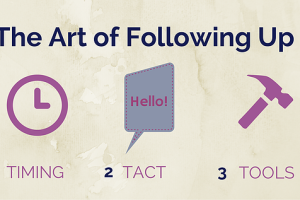Like so many sales techniques, knowing when and how to ask questions with prospective customers is more like an art than a science. Asking the right questions can build rapport, demonstrate competence, and customize a sales approach to a particular customer’s needs. Asking the wrong questions, on the other hand, makes a salesperson seem incompetent, insensitive, or lazy.
That means this is a task we need to approach thoughtfully, with plenty of advance preparation. Let’s take a look at some questions that can help us qualify leads and keep our sales conversations moving in the right direction (they may seem obvious, but I promise you most people aren’t asking them).
Do you mind if I ask a few questions so I can better understand your needs?
It’s smart to get in the habit of asking for permission to ask questions in the first place. There are a couple reasons for doing so.
First, it prepares clients for a more interactive, solution-driven conversation that starts with their needs rather than our sales goals.
Second, it demonstrates respect and courtesy, helping prospects assume a less defensive posture when we ask for clarification on something.
Most clients will appreciate the gesture and gladly assent, but we must not treat this as a license for putting our customers “on the spot” during the conversation. The last thing you want your prospects to feel is that they’re under interrogation. Use care in your word choices and allow them to open up and let the information flow.
What are your organization’s top priorities this year?
This question is extremely important for us to ask early in the process. ‘These priorities’ are typically what drive all decisions throughout the year for what the company will invest in and what the executive decision makers will sign off on. So asking about our prospects’ organizational goals opens the floor for them to talk about the things that matter most to them while simultaneously allowing us to ascertain whether our solution is going to be a good fit for their company.
In the best-case scenario, we’ll discover that our product is well positioned to help a client meet his or her objectives, and we can tailor our presentation to resonate with those objectives. But even if we learn that a prospect’s needs are grossly out of line with our proposal, we can demonstrate professionalism and perhaps earn a future referral by candidly admitting that we’re probably not the right people for the job.
What problems are you encountering in achieving your objectives?
This question works on two levels.
First, it demonstrates that we care more about understanding our customers’ needs than about pushing product features—which may incline our prospects to listen more charitably when the time comes for us to propose a solution.
But perhaps more importantly, this kind of question probes for those “pain points” which, if properly addressed, will most likely compel a customer to take action.
Perhaps we’ll discover that we’ve addressed similar problems with other clients in the past. If so, I’d suggest you propose using that background as a springboard for going deeper: “Many of our clients are reporting problems with areas A, B, and C. How are these affecting you?”
Asking a follow-up question like this allows us to passively leverage our competence into an opportunity for some targeted discussion about deeply felt needs within the customer’s organization. Discovering the real problems that our customers face is the most important goal of a sales interview, so keeping the conversation going on this point is critical.
What would your organization be able to accomplish once these problems are resolved?
This question gets the prospect thinking about the “other side” of the problem. It invites him or her to fantasize about the efficiencies to be gained, the personnel hours to be reduced, or perhaps the new projects that could be taken on as a result of implementing our solutions.
In short, it puts our prospects in a “happy place” from which they can begin assigning real, tangible value to the product we’re about to offer. If the rest of the meeting goes well, we can return to these insights during follow-up negotiations.
Are you considering other solutions right now?
This is a subtle and non-threatening way of asking, ‘who is my competition?’ This can reveal whether our solutions are similar to or entirely different from the alternatives our customers are considering. Not all prospects will be forthcoming about which competitors they are considering, of course, but even if they volunteer only the most basic information, we can always ask, “What have you liked—or not liked—about what you’ve seen so far?”
This kind of approach maintains the respectful, solutions-oriented tone we’ve already established and shows that we’re not necessarily as interested in beating our competition as in making sure that we deliver the kind of experience the customer is looking for.
What does your decision-making process look like for this project?
This question is basically a polite request for clients to disclose several key pieces of information: their individual roles in the decision-making process, their time frames for reaching a decision, and (most likely) their basic level of motivation to act.
This allows us to determine whether our prospects are just shopping around or seriously zoning in on an implementation schedule, and we can adjust our strategies accordingly.
What is most important to you in selecting a vendor for this project?
Most of our clients will have worked with a number of vendors besides us, so they will have learned the hard way what works and what doesn’t in their vendor-client relationships.
Asking about these experiences during a sales interview indicates our interest in accommodating a prospect’s specific needs, not just in terms of the solution we have to offer, but also in terms of service after the sale.
Occasionally, a prospect may describe having a negative experience with a previous vendor. For such an occasion, try this one out for size, “If you work with us, what are you hoping will be different?” This puts us the customer in the driver’s seat, making it clear that his or her priorities will set the agenda in the relationship.
What concerns do you have about moving forward?
TONE MATTERS!!
When a sales prospect shows hesitation before moving to the next step, the first instinct may be to avoid the reluctance and forge ahead. However, by doing so many sales people only find that the prospect bows out of the pipeline at a later stage after a great selling opportunity has passed.”
Seasoned salespeople learn to recognize prospects’ peculiar signs of ambivalence. Rather than push forward, they take the time to address these concerns directly, recognizing that it’s far better to identify an obstacle and overcome it than to spin their wheels trying to circumvent it.
A direct question indicates that we’re paying attention and that we value our prospect’s time too much to waste it by continuing with a presentation that may not be addressing a matter of special concern.
How would you gauge your interest in our solution?
There comes a point in some sales presentations when, in spite of our careful efforts to address those “pain points” our clients have expressed, we begin to sense that we’re making little progress. It’s useful at that point to frankly ask whether we’ve made any impact so that we can decide whether to continue. It may be that we’re talking to the wrong person and need to redirect our efforts upward to a better-positioned decision-maker. Or it may be that we’ve already said enough to convince a prospect that we’re out of their league.
In certain circumstances, if the sales prospect is not qualified or not ready to buy, moving on to the next opportunity may be in your best interest to close more sales. It’s always better to be true to yourself. Don’t get sucked into the beautiful lie. Appreciate the terrible truth, and move on.
“How would you prefer that I follow up with you?”
Some people are irritated by a salesperson who calls the next day to see whether a decision has been made yet. Others are offended if they don’t receive an email within a few hours of the initial meeting.
It pays for us to learn something about our prospects’ communication habits before ending the meeting so that we can follow up in a manner that accommodates their style of doing business. If the meeting went well, this information helps ensure that we keep the relationship positive. If the meeting didn’t go so well, this information can help us maintain professionalism and perhaps come at the customer’s problems from a different angle at a later date.
Of course, we should always frame our questions according to our unique circumstances, recognizing that no two clients are exactly the same, even when they may encounter similar problems. Sometimes we can afford to be more direct, while other times we may need to creatively rephrase our questions. We also do well to heed the warning of bestselling author Andrew Sobel, who reminds us that customers are not likely to respond well to questions that could be perceived as manipulative, clichéd, self-aggrandizing, judgmental or sarcastic. “Good questions are sincere,” he says. “They reflect a genuine curiosity. They are open-ended. They get at the ‘why’ of things. They explore implications. They challenge assumptions. They help you connect on a personal level.”
And that’s why great salespeople take them seriously.








